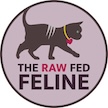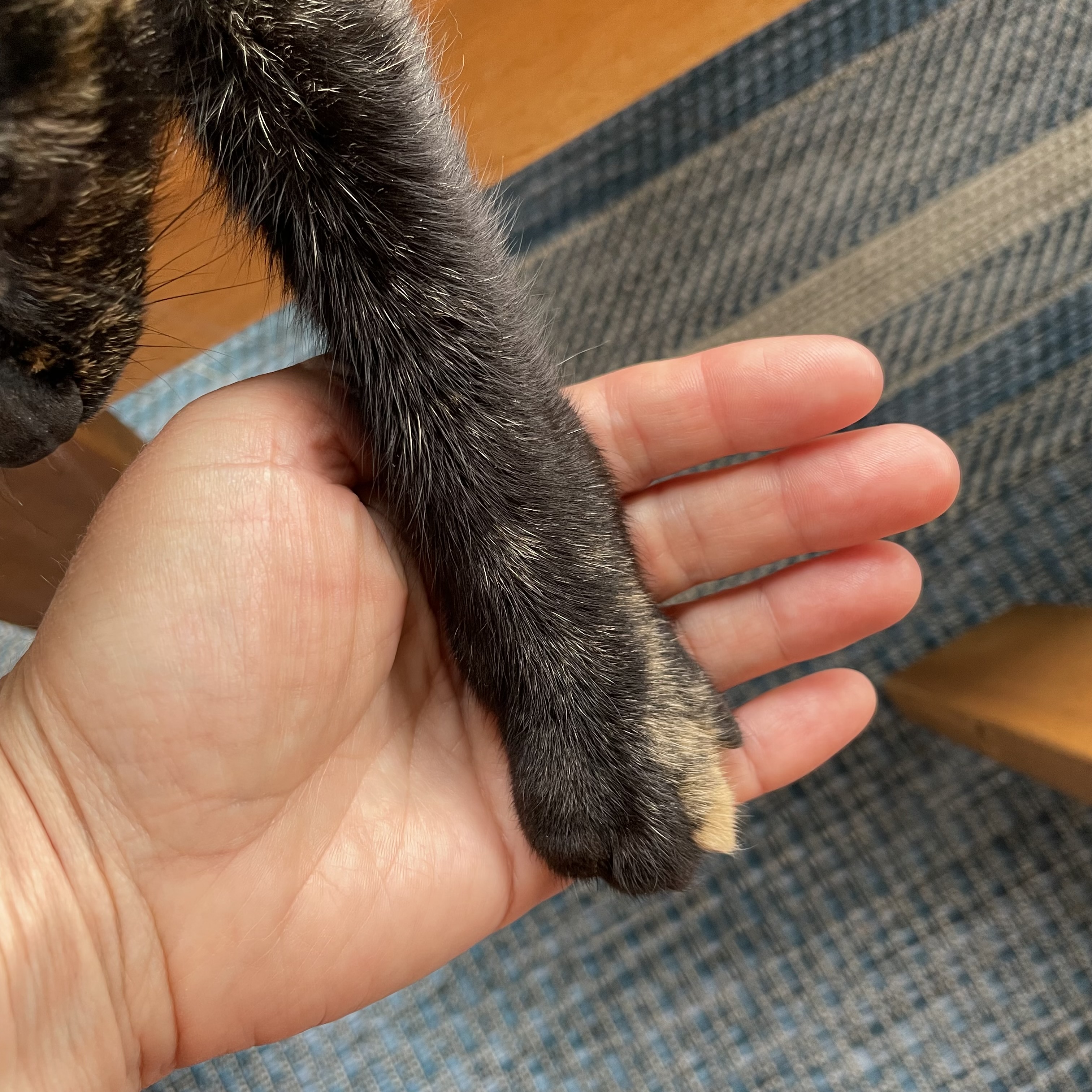When it comes to raw feeding and balance, the first thing we often think of is balance in relation to the food. Are the macro and micro nutrients balanced? Is the food “complete and balanced?” But I am going to suggest some other ways to think about balance when feeding a raw diet.
First, I propose that we re-think what a balanced diet actually means. This notion of “complete and balanced” food is unhelpful and inaccurate. More on that coming up. Second, I think we need to consider the cat parent’s sense of internal balance in the equation. Our cats don’t feed themselves, they rely on us to do so. When we are out of balance, that will have a significant impact on our cats.
As a feline nutritionist and clinical psychologist, I think about both of these aspects of balance: the food and the cat parent. Both contribute to the success of feeding your cat. I think it’s important to consider what the cat parent is bringing to the feeding situation. Feeding our cats does not exist in a vacuum, it is a complex interaction between them and us in relation to food. Too often we leave out the person and only focus on the cat and the food.
Let’s take a look at this notion of balance when feeding a raw diet.
Complete and balanced?
First, the food. We have all heard this phrase: “complete and balanced.” It is splattered all over commercial foods and touted on marketing materials. It is used by pet food companies to make us think that they are the only ones who could possibly understand the “exacting science” of making our cats’ food. That since it is “complete and balanced,” the food can be fed as your cat’s sole diet, since every nutrient is provided for. Further, that if we don’t feed this “complete and balanced” food, then our cats will surely have deficiencies in their diets and we would be neglectful cat parents. There are several problems with this, one—it isn’t true, and two—these so called “complete and balanced” foods don’t have anything to do with how cats are actually designed to eat a balanced diet.
AAFco guidelines
Why isn’t this true? This isn’t true because of how AAFCO guidelines work. These guidelines are minimums (with a few maximums), not exact amounts. It is not anywhere near as precise as pet food companies would have us believe. All of these “complete and balanced” foods can have a wide range of protein, fat, and carbohydrates, as well as vitamins and minerals. This in itself it’s necessarily terrible, except for the way it is promoted as a precise diet with exacting standards that is the only food your cat will ever need.
This marketing leads us to believe that we are providing a precise level of nutrition if feeding one of these foods. By this reasoning, all “complete and balanced” foods must have the same nutritional profile, right? Nope. And if only feeding one of these foods, then the cat is only eating a diet with that particular nutrient profile. Doesn’t actually sound much like balance.
This notion of “complete and balanced” nutrition contributes to the damaging idea that homemade diets could not possibly provide what a cat needs.
Nature’s version of balance
If feeding a so called “complete and balanced” food is not really what it purports to be, how do we provide a truly balanced diet? I think Mother Nature is a pretty credible source here. After all, cats have been around for millennia eating the diet nature provides. So, how do cats eat a balanced diet in the wild? They eat a variety of whole prey animals that are available in their environment. They are not calculating nutrients, although they are able to regulate their intake of macronutrients (protein, fat, and carbohydrates) quite well.
Cats are generalist obligate carnivores. This means that they do not eat only one kind of animal, but a variety of animals. Mice, rats, chipmunks, voles, rabbits, songbirds, lizards, etc. These prey animals will vary in terms of male and female, young and old, sick and healthy. The nutrient profile of different animals is unique and varied. For example, mice have much more vitamin A than rats do. Baby animals will have less calcium than adults. But the overall diet provides the nutrients needed with balance achieved over time. Nature shows us that cats should eat a varied diet of species appropriate foods to receive balanced nutrition.
variety in rotation
When it comes to raw feeding, there are so many ways to provide a species appropriate, varied diet. You can vary the individual proteins and organs fed, vary the fat content, include red and white meats, feed commercial and homemade foods in rotation, offer freeze dried and fresh foods, alternate the kinds of fish included, give different textures of food, include eggs from different birds, etc. Feeding variety in rotation is key when raw feeding and is what actually allows for a truly complete and balanced diet.

Balance for ourselves
lack of support
Now let’s think about the cat parent and balance when it comes to raw feeding. Many pet parents are going against veterinary advice or sometimes just not sharing with their veterinarian that they are feeding their cat a raw diet. It can be really hard to go against your vet. We trust our vets with our cats’ health and well being. We trust them when our cats are sick or injured. We trust them to perform surgery on our pets when needed. It can be really hard to not have their support when it comes to nutrition.
Additionally, we may not have the support of our family members, partners, friends, or roommates. It can be exhausting to defend your choices. It’s hard to not second guess what you are feeding when so many people challenge you about it. This lack of support can weigh heavily on our minds. Then, if our cats reject a meal, we can feel so discouraged and question our choices further. This sense of doubt can easily creep in when we don’t have support from others.
fear of harm
Another tricky aspect for pet parents to manage is the fear of harming your cat. There is so much fear mongering against raw feeding. The last thing any of us want to do is cause harm to our beloved cats. We started investigating raw feeding because we want to do the best for them in terms of nutrition and health. But the thought that you could be making a grave mistake, make your cat sick, cause deficiencies over time, etc., can be hard to quiet in our minds. The fear of causing harm can erode our confidence in how and what we are feeding.
Subsequently, it can be easy to get caught up in the idea of making sure every nutrient is in every meal at the so-called perfect amount every time. As discussed earlier, cats do not eat this way in nature and it is not a necessary goal when raw feeding. Perfectionism is so detrimental to this process. Fears of not making the food perfect can often derail and burn out the most committed raw feeder.
Related to perfectionism and equally detrimental, is all or nothing thinking. Not many raw feeders go from feeding dry or canned food to making DIY food overnight. Starting small, taking little steps, and learning along the way are all much better ways to enter the world of raw feeding. You can begin with just adding a piece of plain meat to your cat’s dish. Or offer some commercial raw food to start. And then build slowly from there. There are lots of options and it takes time to figure out which might work best for you and your cat. As the saying goes, Rome wasn’t built in a day, and neither is a raw diet.
impact on our cats
When we are dealing with these noisy worries in our head—worries about making our cats sick, not feeding raw correctly, not including every nutrient, and making an Instagram picture-worthy raw dish each meal, that stress is communicated to our cats. Cats are truly such sensitive beings. They are very tuned into our emotional state. So if we are stressed, frustrated with ourselves, and worried we’re harming our cat, they can feel that energy.
Now picture putting down your cat’s dish with that energy. If it is a new food, your cat will certainly question whether it is safe to eat or not. When a cat is feeling emotionally unbalanced and stressed, this can impact their appetite and approach to the food.
Feeding time can be a time for connection and enjoyment. We want to be mindful to manage our emotional state when we feed our cats. We want to find the joy and pride in feeding our cats a species appropriate diet for ourselves and for them.
Importance of community
One way that we can we find balance for ourselves is through community. Finding a sense of community and support from other raw feeders can be so important in this process. There are FaceBook groups, Instagram and TikTok accounts, local raw feeding co-ops, countless websites and blogs, books, YouTube videos, and certified nutritionists who offer individual services. Any and all of these might be helpful as you navigate the world of raw feeding. It’s a lot to sort through and not all the information is accurate or credible, so take your time, ask questions, find sources you trust.
While raw feeding may not be completely mainstream yet, there is a growing community of raw feeders. Think about what you need to feel confident feeding your cat a raw diet and seek that out for yourself. You are an important part of the feeding equation along with your cat and the food you provide.



4 responses to “Balance When Raw Feeding: What do we need to consider?”
This was a lovely article! Thank you for your time and dedication to this and the wealth of knowledge you provide.
I’m so glad that you found it helpful!
Are you concerned about conventionally raised meat for cats? The animals are fed gmo grains and are often kept in poor living conditions, and I am concerned about the effect on the animal and the meat….and the effect on my cats. Yet I cannot afford to always feed organic and pastured !
Can you please share your thoughts on this?
Thanks so much!
Yes, it is a concern for all of the reasons you mentioned. I think we just have to do the best that we can in our circumstances. If we are able to use organic, pasture raised meats, that’s ideal, but it is not always feasible or even available. In those cases, we have to do the best that we can. Feeding a variety helps with this issue as well since different animals receive different treatment, diets, etc.